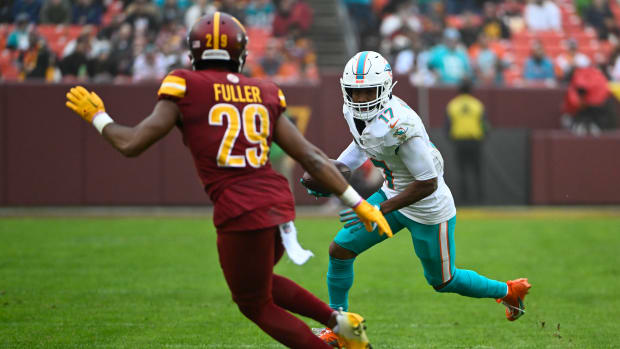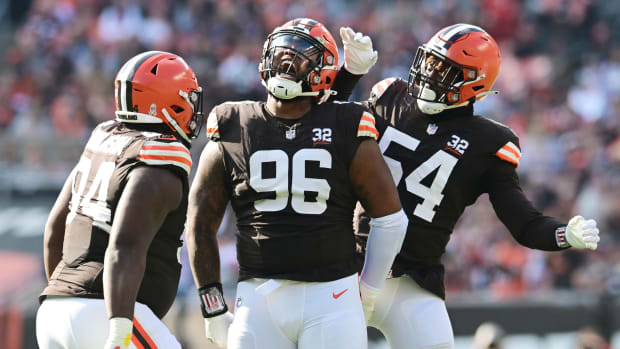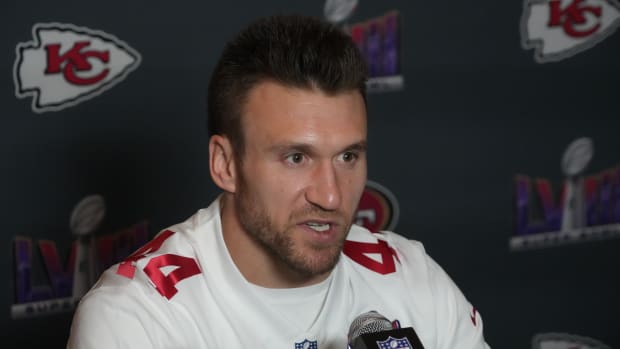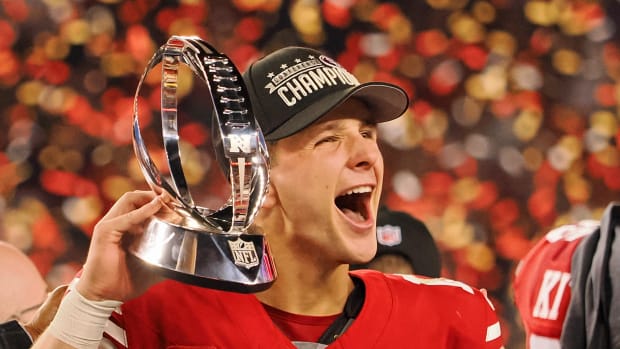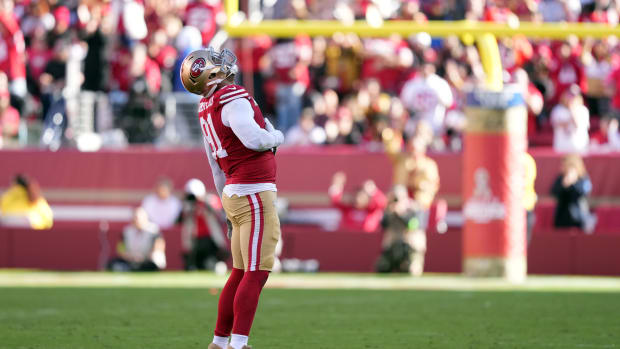49ers vs. Eagles: Contrasting Visions
For the second straight year, the 49ers and Eagles find themselves atop the NFC and are favored to meet again in January to determine who goes to the Super Bowl. While both teams have reached a summit of consistent excellence, their blueprints are markedly different.
GENERAL MANAGER
Howie Roseman – The core of Roseman’s blueprint is a constant investment of first-round picks in both trenches. Combining this with an aggressive coach, the trench investment is what enables Philly to win in multiple ways.
The Eagles' offensive line dominates in the run and pass protection, which gives the team multiple ways to win on offense where they can run to move the chains or go into a dropback passing game to come from behind.
In addition, a great offensive line with a physical running quarterback and an aggressive coach trusting the analytics takes away passing situations. Philly can run on 3rd and 7 with D’Andre Swift or Jalen Hurts knowing they have the 95% success rate “brotherly shove” in their back pocket on 4th down. That defuses the Niner blueprint counting on 3rd down passing situations to unleash the pass rush.
Kyle Shanahan – While John Lynch has the title, Shanahan has final roster control, and Lynch works for him. Shanahan traded up for Trey Lance, makes the 2nd and 3rd round offensive weapon reach and bust picks, and sets the team blueprint.
Where the teams differ is Philadelphia is built to pivot to any situation and win in multiple ways through their investment in both trenches. The Niners are built to win one way, get the lead then keep it, with an investment in weapons on offense and the pass rush on defense.
Shanahan uses the offensive line for cap savings, going cheaper with late-round picks for every offensive line position except left tackle. The remaining four players are selected for the outside zone running game. Pass protection is sacrificed, leaving it to the quarterback to evade the rush with quick throws and scrambling.
In last year’s NFC Championship, Brock Purdy had yet to develop the pocket awareness and confidence to step up in the pocket and evade the rush in either direction. Eagles edge Haason Reddick beat 3rd string tight end fresh off the inactive list Tyler Kroft and didn’t bite on play-action. Then Purdy didn’t step up, injured his elbow, and the game ended.
While the Niners claimed that was a fluke injury and they would have won otherwise, Philadelphia had pressures on an absurd 61.9% of Niner dropbacks. Prime Joe Montana could have been the quarterback and they still would have lost.
The Niners offensive line was a revolving door because the Shanahan blueprint doesn’t invest in pass protection across, which makes it far more difficult for them to come from behind. Which is why the Niners under Shanahan are 0-37 when trailing by at least eight points in the 4th quarter (stat from AP's Josh Dubow).
It’s not about Shanahan the coach, it’s not about whether Purdy can lead a comeback, it’s about Shanahan the GM. His roster blueprint sabotages the team’s ability to come from behind.
Which brings up another key difference. Roseman says never be afraid to make mistakes, but when you do, fix them quickly. Shanahan does not, he maintains his cap savings through the offensive line credo. The Niners' weakness on the right side of the line has been evident for years but goes unfixed.
2019 Super Bowl loss, Jimmy Garoppolo went 1-9 when pressured and threw two picks. 2021 NFC Championship, lack of ball skills in the secondary, fixed. 2022, Philly has a 62% pressure rate from their D Line and Jason Kelce put his man on skates in the run game. Why don’t the Niners get through for a ring? There’s the answer. The Shanahan blueprint.
Will that blueprint cost the Niners this game on Sunday? If Reddick and the Eagles defensive line have another big game, yes.
The good news for the Niners is there’s an easy fix in the upcoming draft. Take what you have not. A right tackle in the first, a corner in the second, a guard in the third. Shanahan maintains his cheap offensive line but upgrades the talent dramatically. If they draft well, lingering mistakes are finally fixed. I believe the Niners will win next season’s Super Bowl if they draft intelligently in April.
HEAD COACH
Nick Sirianni - The studio gangster of the NFL. Tough guy yells at the Kansas City crowd in the safety of the tunnel and plays to the camera. Sirianni’s persona has all the authenticity of cubic zirconia. He’s a junior high school punk granted a wish from the genie to be an NFL head coach. A lack of professionalism and maturity combined with excess mugging for the camera.
If the league held a fundraiser of throwing pies in Sirianni's face for 20 bucks there’d be a line around the planet. Karma is waiting for Sirianni with a 2x4.
Sirianni is insufferable but there’s no denying his ability or his record, winning 27 of his last 29 games with potentially two straight Super Bowl appearances, and maybe this time a ring. 10-1 this year after losing one of the best offensive coordinators in the league Shane Steichen, doing an excellent job leading the Colts.
Part of Philly’s record undeniably belongs to Roseman. That said, Sirianni and his staff have made the adjustments to come from behind to win four times this year including from ten down at halftime to Kansas City and Buffalo.
Kyle Shanahan – One of the elite play designers in the league, scheming targets wide open. Shanahan’s opening drive scripts this year have consistently produced points to feed the game script of playing with a lead.
Shanahan is among the league’s best in assembling and mentoring a great coaching staff with some of the top position coaches in the league. He and Lynch have used coaching and management hires to reap a harvest of comp picks, something Philly caught on to late and is now copying.
The issue has never been Shanahan’s coaching, it’s his blueprint. We’ll see if that can be overcome on Sunday.

